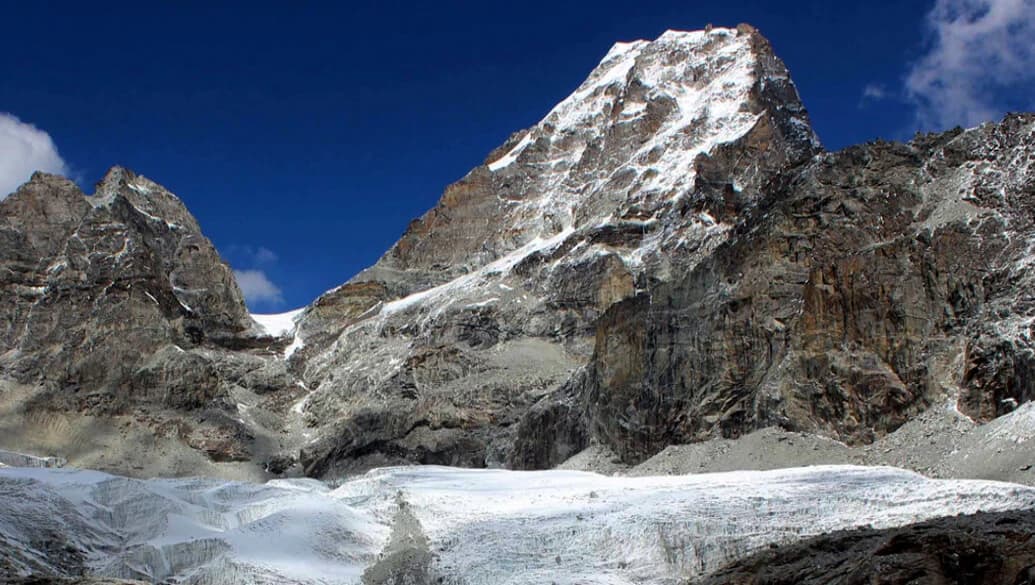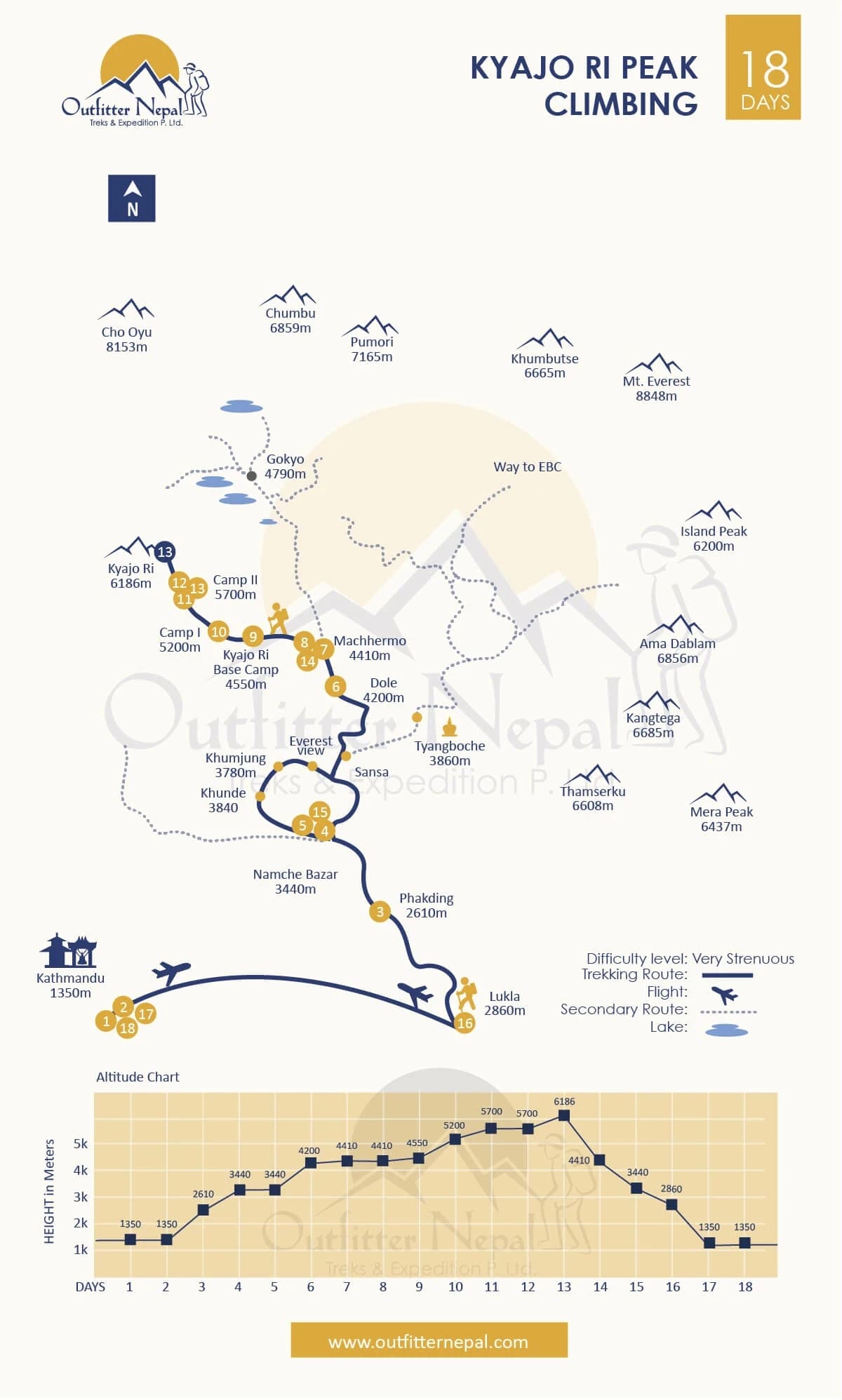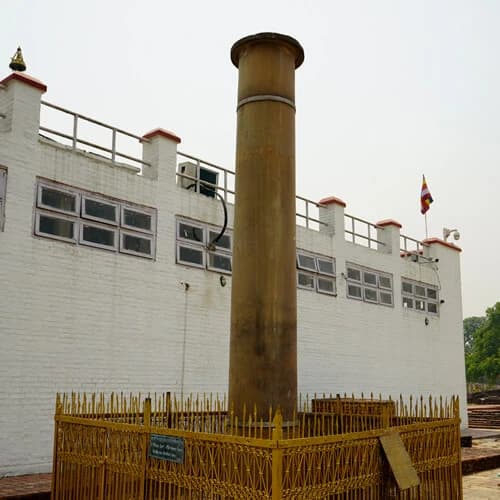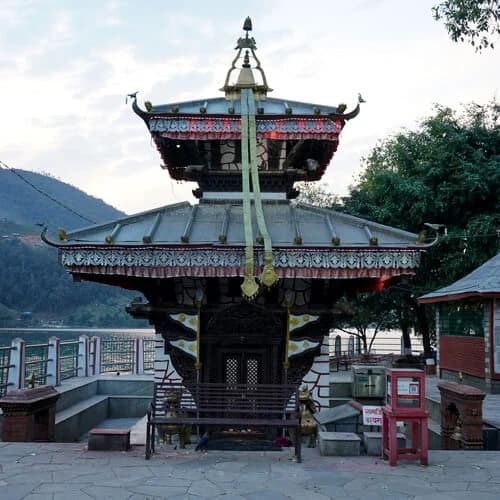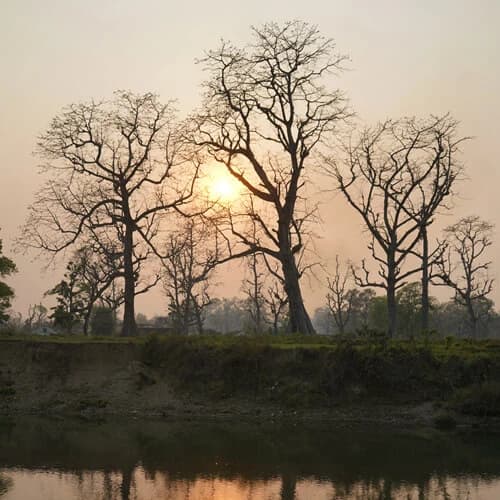Kyajo Ri Peak Climbing in Nepal provides a unique experience of climbing a 6000m trekking peak that is rarely ascended. The Kyajo Ri Peak Climbing Itinerary blends the tranquil experience of mountain climbing with strolling through a stunning woodland setting. You will be satisfied by the majesty of massive waterfalls, the calm yet thrilling sound of river currents, and the elegant appearance of towering mountain summits. Climb one of the lesser-known hiking peaks with trained guides, followed by a well-planned itinerary that allows for optimal acclimatization and climbing routine.
Kyajo Ri Summit is a semi-technical mountain peak located between the Thame and Gokyo valleys, standing at 6,186 m/20,296 ft. Kyajo Ri is less popular than the nearby summits, yet it offers the exhilarating adventure of climbing a 6000m peak in a pure expedition style. This mountain climbing expedition is ideal for adventurers who want to climb the mountain in solitude without encountering too many people. It was only in 2002 that the Nepalese government opened it to trekkers.
If you're seeking an adventure on a 6000-meter summit, Kyajo Ri is the place to go. The Kyajo Ri excursion combines intermediate rock climbing with high alpine ice climbing. Similarly, it provides demanding and breathtaking vistas of summits exceeding 8000 meters, including Mt. Everest (8848 meters), Mt. Lhotse (8516 meters), Mt. Makalu (8463 meters), Mt. Cho Oyu (8201 meters), and other magnificent high peaks in the Khumbu Himal range. Climbing Kyajo Ri will strengthen your Alpine Mountaineering skills while also providing an exciting Himalayan alpine expedition experience.
You'll pass through some beautiful places, such as Phakding, Namche, and Mende, where you may get a glimpse of the Sherpa way of life in the Himalayas. You will be humbled by the kindness and generosity of the people who live in the beautiful Khumbu region. On your journey to climb Kyajo Ri Peak, you will pass through dense forests with pine, oak, and rhododendron trees. You will be grateful that amazing animals like the Ghoral, Musk deer, Himalayan Thar, and others have their natural homes in the Everest region. Thanks to our amazing Kyajo Ri Peak Climbing Voyage, you will surely have the most thrilling adventures of your life.
Join Outfitter Nepal on your 18 days Kyajo Ri Peak Climbing in Spring and Autumn! We have an excellent itinerary for climbing the Kyajo Ri Peak that includes airport pickup and drop, Lukla flights, as well as a day tour of Kathmandu. It covers a wide range of excursions that will undoubtedly provide you with a true feeling of tranquillity alongside adventure. We provide both group and private departure trips to Kyajo Ri in Spring and August.
Best Features of the Kyajo Ri Peak Climbing
- Climbing the 6000m+ Kyajo Ri mountain peak in the Everest region
- Enjoying the aerial view of the Himalayas on a flight from Kathmandu to Lukla and back
- Indulging in a combination of rock climbing and steep alpine ice walking
- Taking in the breathtaking views of the nearby peaks such as Everest, Makalu, and Lhotse
- Witnessing the distinct customs and culture of the locals, as well as their simple way of life in the mountains
- Trekking through the rich flora and fauna of the Sagarmatha National Park
- Indulging in a mountain climbing expedition in a secluded valley featuring a lovely, cozy, and peaceful base camp
- Traversing difficult terrain and freezing crevasses to have an exhilarating adventure
Which route do we follow to summit Kyajo Ri Peak?
After visiting several UNESCO World Heritage Sites in Kathmandu, the 18 days Kyajo Ri Peak Climbing Itinerary begins with a breathtaking alpine flight to the airfield in Lukla. The Kyajo Ri Trek starts at Lukla and proceeds to Namche Bazaar, the capital of the Sherpa people, via a path that hugs the Dudh Koshi River and passes through a verdant forest of oak and rhododendron trees. After acclimatizing in Namche Bazaar, you will continue on the path, which is a gentle rise all the way to Kyajo Ri Base Camp via the lovely towns of Gongla, Phurte, and Mende. After getting used to Kyajo Ri Base Camp, you will ascend to Camp I.
You will proceed to Camp II after spending one more day relaxing in Camp I to get used to the surroundings. Our Sherpa staff at Camp II will do the necessary examinations on your climbing gear and physical condition before moving on to the summit of Kyajo Ri Peak. The next day, you will ascend Kyajo Ri Peak and spend the night at Camp II. The rest of the journey is downhill from this point on. From Camp II, you will descend to Base Camp, then to Namche Bazaar, and lastly to Lukla. After you take off from Lukla, your 18-day Kyajo Ri Peak Climbing Itinerary will come to an end in Kathmandu.
How difficult is it to climb the Kyajo Ri Peak?
At 6,186 meters above sea level, the Kyajo-Ri Peak Climb is a fascinating technical challenge. It is an incredible opportunity for those who are willing to climb a mountain above 6000 meters in elevation, although it is not as extreme as its altitude suggests. The ascent of Kyajo Ri Peak is a unique peak-climbing experience that combines ice and mountain rock climbing. While climbing Kyajo Ri Peak is challenging, there are a lot of additional benefits as well. For individuals who want peaceful experiences, this peak is ideal as it is not often visited by large groups of people.
The trail's slippery and frozen rocks pose a special risk to novice hikers. Trekkers have to maneuver across icy patches or snow-covered rocks. Hence, they must possess extreme endurance and stamina to navigate the rugged and challenging terrain of the area. Altitude sickness and fatigue are also common in this area due to the region's higher altitude and thin air. Because of the high altitude, even seasoned hikers may get altitude sickness. We offer a special schedule that enables you to acclimate sufficiently to prevent AMS (Acute Mountain Sickness) while climbing Kyajo Ri Peak.
How to train for Kyajo Ri Ascent in Spring and Autumn?
You need to dedicate months in advance to your training if you want to successfully complete the trekking and climbing adventure to Kyajo Ri Peak. The path requires daily ascents to high altitudes while towing a large load. As a result, the voyage calls for a blend of several tactics, such as strength training and aerobic activities, to increase your body's endurance. One way to strengthen your core and use it while climbing is through aerobic exercise. Stated differently as cardiovascular exercise, it is a prerequisite for being ready for treks and climbs.
The purpose of cardiovascular training is to prepare you for the low oxygen concentration that occurs at high elevations. The adaptation of your heart, lungs, and blood cells to these conditions is enhanced by aerobic exercise. If you reside in a mountainous region, you can wear your trekking shoes and a backpack and go on several hikes each week. Additionally, you can work out on treadmills by gradually increasing the inclination and duration of your workouts while carrying weights on your back.
Why climb Kyajo Ri Peak with Outfitter Nepal?
With more than 2 decades of industry experience, we provide all the necessary services with the utmost safety in mind, allowing you to successfully finish the ascent stress-free. This is a list of everything we provide:
- Our team carries an emergency pack that contains a backup oxygen bottle, regulator, and mask
- There are channels of communication available for use when climbing.
- We have excellent connections with rescue airlines in case of a high-altitude incident.
- We provide weather updates, particularly for the day of the Kyajo Ri Peak summit.
- We employ a group of experienced porters, knowledgeable trekking guides, and competent Sherpa climbers. They can speak several languages, have a great deal of experience climbing at high altitudes, and, most importantly, are amiable and supportive.
- A warm-down jacket will be given to each passenger for the duration of the trip.
Kyajo Ri Peak Climbing Cost
Our 18 days Kyajo Ri Peak Climbing Package cost ranges from US$ 2800 to US$ 3500 depending upon the number of people in the group. If you are a group of 5 to 8 travelers, the cost of the package amounts to US$ 2800. Likewise, for a group of 2 to 4 climbers, Kyajo Ri Peak Climbing Cost goes out to be around US$ 3200. If you are a solo traveler, the cost of the package gets a little expensive with around US$ 3500 on the budget. This is the cost of the standard trekking package.
However, if you wish to modify the package to fit your convenience, we are here to help you. If you want to include more traveling days or extend your days of stay, the cost of the package will be altered. However, we try to be as flexible as possible to meet your needs. You can try different add-ons to your trip while booking the trip package.
Major Attractions of the Kyajo Ri Peak Climbing
An exciting flight from Kathmandu to Lukla and back
The 35-minute journey from Kathmandu to Lukla is regarded as a nerve-wracking one that offers breathtaking Himalayan vistas and an exhilarating flying experience. Climbing the Kyajo Ri Peak begins at Lukla. The Lukla Airport is considered riskier than the average commercial airport. Airlines have reduced the number of aircraft that are permitted to fly the route and tightened their regulations around what constitutes an acceptable flight situation. Even with the advancements in passenger safety, traveling to Lukla may still cause anxiety. The rush of excitement, however, makes the trip worthwhile!
A peaceful stroll through Sagarmatha National Park
You enter Sagarmatha National Park prior to Namche Bazar at Monjo. This park is recognized as a UNESCO World Natural Heritage Site. There are hundreds of different plant and animal species in the park. The path leads to Namche Bazar over a difficult ascent. The national park's openness to the outside world is embodied in the Great Himalayan Range, which is home to Mt. Sagarmatha (Everest) and other stunning snow-capped summits, as well as sizable Sherpa populations. The spectacular majesty of the high, geologically young mountains and glaciers, along with the area's carefully conserved natural heritage, have made the trip to Kyajo Ri Peak incredibly inspirational.
Acclimatizing in the infamous Namche Bazaar
The Khumbu region's main tourist destination is Namche Bazaar. With amenities like Wi-Fi, excellent connectivity, electricity, cafes, libraries, museums, etc., it is the most developed village in the Everest region. While spending a few nights here, you take a short journey to locations like Syangboche Airstrip and Everest View Hotel to help you acclimate and see stunning vistas of the Himalayan Mountains. With its shops, eateries, lodgings, ATMs, and other amenities, Namche is a bustling marketplace. Every curve in the narrow lane of the Namche Bazaar, frequented by residents, Sherpa vendors, monks, and yaks, reveals a new alternative, ranging from bakeries to museums to temples.
Discovering the unique customs and culture of the Sherpas
You can observe Sherpas and people from different villages living along the trail. One of the main highlights of the trip that you won't find anywhere else is the inhabitants' culture and traditions. The Khumbu region still adheres to centuries-old customs and has an extremely rich cultural history. Even with all of the tourists in the area, the Sherpas have been able to maintain their old culture. You will encounter prayer wheels, chortens, stupas, and historic monasteries while walking. The reverence that the Sherpas have for their faith and culture is also evident in these centuries-old monuments.
Scaling the summit of Kyajo Ri Peak
Kyajo Ri Peak climbing is an exciting and difficult experience. You establish a few different camps along the way and work your way up to the summit. During tough sections and when fixing ropes, our Sherpa guides assist you. They also teach you the fundamentals of climbing and, if needed, how to utilize gear properly. We ensure that you not only securely ascend to the summit but also safely descend. Reaching the top of the Kyajo Ri mountain is the highlight of this expedition.

